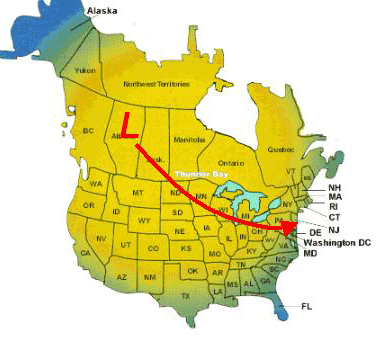This is the second of a series of blogs for Dr. Kevin Czajkowski’s surface-temperature field campaign. It is exciting to see how many schools are participating! Here in Colorado, we ate our lunches outdoors earlier this week, while the eastern U.S. was quite cold. In contrast to Ohio, where Dr. C. lives, Boulder, Colorado’s snow was quite late this year. The “official” first snow as measured for our “snow pool” was on 4 December! Other parts of Colorado (and Boulder’s official Weather Service site) got snow before 4 December, but still much later than average.
Hi All,
As of December 4, 2008, there were 207 surface temperature observations from 27 schools added to the GLOBE website. Go Team! This is great.
Here are schools that have entered data so far in the field campaign:
Roswell Kent Middle School, Akron, OH, US [12 rows]
Dalton High School, Dalton, OH, US [12 rows]
The Morton Arboretum Youth Education Dept., Lisle, IL, US
Peebles High School, Peebles, OH, US [32 rows]
Gimnazjum No 7 Jana III Sobieskiego, Rzeszow, PL [6 rows]
Penta Career Center, Perrysburg, OH, US
Canaan Middle School, Plain City, OH, US [2 rows]
Brazil High, Brazil Village, Trinidad and Tobago [6 rows]
Kilingi-Nomme Gymnasium, Parnumaa, EE [12 rows]
Swift Creek Middle School, Tallahassee, FL, US [2 rows]
National Presbyterian School, Washington, DC, US
Maumee High School, Maumee, OH, US [4 rows]
Whittier Elementary School, Toledo, OH, US [2 rows]
Huntington High School, Huntington, WV, US [8 rows]
Warrensville Heights High School, Warrensville Heights, OH, US [2 rows]
Bellefontaine High School, Bellefontaine, OH, US [8 rows]
Oak Glen High School, New Cumberland, WV, US [12 rows]
Nordonia Middle School, Northfield, OH, US [5 rows]
Orrville High School, Orrville, OH, US
Bowling Green Christian Academy, Bowling Green, OH, US [3 rows]
Highlands Elementary School, Naperville, IL, US [4 rows]
South Suburban Montessori School, Brecksville, OH, US [4 rows]
John Marshall High School, Glendale, WV, US [28 rows]
Birchwood School, Cleveland, OH, US [10 rows]
Hudsonville High School, Hudsonville, MI, US [9 rows]
The University of Toledo, Toledo, OH, US [4 rows]
Main Street School, Norwalk, OH, US [16 rows]
If you have entered data today and do not see your school’s name, do not worry. The database is updated each night. I expect that there will be many more schools involved this year.
I love the comments that the students put with your observations. Here is one from Roswell Kent Middle School, “shoes sunk into mud approx. 40 mm deep.”
Oak Glenn High School, “Buses had recently (past 10 minutes) driven around the perimeter of this surface.”
Peebles High School, “SLIGHLY WINDY AND VERY COLD!!!!!!!!!!!”
Sorry about the cold. That seems to be a theme of everyone’s observations. Field work is sometimes dirty and you have to endure difficult situations. Take a look at this picture of me doing field work in Oklahoma in 1999. I was nervous about the bull.
Figure 1. Dr. C. doing field work on an Oklahoma Pasture.
The cold weather sure has arrived in the Great Lakes. Temperatures are averaging 5-8º C below average for this time of year. I set up an ice rink in the back yard of my house this morning for my kids to skate on. The last two years I was not able to get ice to form until mid January. The cold weather is going to stick around in the eastern United States for a least another week as well as in Estonia. Trinidad and Tobago is in the tropics and stays warm all year long so I would expect it to stay that way.
The forecast in the United States is for a series of “Alberta Clippers” to sweep down out of Canada towards the Great Lakes and eventually off the east coast (see the figure below). Each storm will bring 10-30 mm of snow to most areas near the Great Lakes. These storms are very dry because they have not tapped into any ocean moisture. Once the storms pass, they bring very cold air out of Canada behind them. This is how I know that it will be cold for the next week.

Figure 2. Map showing storm (low pressure area, denoted by the L) coming out of the Canadian Province of Alberta (the letters are partially covered by the “L.” These low pressure areas are called Alberta Clippers because they often come out of Alberta.
Dr. C.

